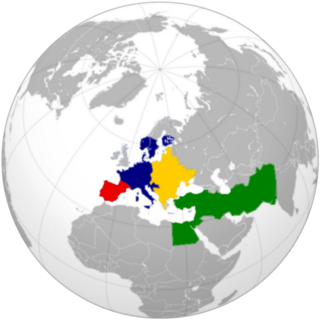Related Research Articles

The Romani people, also known as the Roma, are an ethnic group of Indo-Aryan origin who traditionally lived a nomadic, itinerant lifestyle. Linguistic and genetic evidence suggests that the Roma originated in the Indian subcontinent, in particular the region of Rajasthan. Their first wave of westward migration is believed to have occurred sometime between the 5th and 11th centuries. They are thought to have arrived in Europe around the 13th to 14th century. Although they are widely dispersed, their most concentrated populations are believed to be in Bulgaria, Hungary, Romania, Serbia and Slovakia.

A fairy is a type of mythical being or legendary creature, generally described as anthropomorphic, found in the folklore of multiple European cultures, a form of spirit, often with metaphysical, supernatural, or preternatural qualities.

In ancient Greek religion and mythology, the Moirai —often known in English as the Fates—were the personifications of destiny. They were three sisters: Clotho, Lachesis, and Atropos. Their Roman equivalent is the Parcae.

Oltenia is a historical province and geographical region of Romania in western Wallachia. It is situated between the Danube, the Southern Carpathians and the Olt river.

Mehedinți County is a county of Romania on the border with Serbia and Bulgaria. It is mostly located in the historical province of Oltenia, with one municipality (Orșova) and three communes located in the Banat. The county seat is Drobeta-Turnu Severin.

Gorj County is a county of Romania, in Oltenia, with its capital city at Târgu Jiu. Gorj comes from the Slavic Gor(no)-Jiu, in contrast with Dolj.
Fairies, particularly those of Irish, English, Scottish and Welsh folklore, have been classified in a variety of ways. Classifications – which most often come from scholarly analysis, and may not always accurately reflect local traditions – typically focus on behavior or physical characteristics.

Mărțișor is a tradition celebrated at the beginning of Spring in March, involving an object made from two intertwined red and white strings with hanging tassel in Romania and Moldova, very similar to Martenitsa tradition in Bulgaria and Martinka in North Macedonia and traditions of other populations from Southeastern Europe.
The three Ursitoare, in Romanian mythology, are supposed to appear three nights after a child's birth to determine the course of its life. They are most similar to the Roman Parcae, the Latin equivalent of the Greek Fates or Moirai.

The Kalderash are a subgroup of the Romani people. They were traditionally coppersmiths and metal workers and speak a number of Romani dialects grouped together under the term Kalderash Romani, a sub-group of Vlax Romani.

The Romani people are a distinct ethnic and cultural group of peoples living all across the globe, who share a family of languages and sometimes a traditional nomadic mode of life. Though their exact origins were unclear, recent studies show Kashmir in Northwest India is the most probable point of origin. Their language shares a common origin with, and is similar to, modern-day Gujarati and Rajasthani, borrowing loanwords from languages they encountered as they migrated from India. In Europe, even though their culture has been victimized by other cultures, they have still found a way to maintain their heritage and society. Indian elements in Romani culture are limited, with the exception of the language. Romani culture focuses heavily on family. The Roma traditionally live according to relatively strict moral codes. The ethnic culture of the Romani people who live in central, eastern and southeastern European countries developed through a long, complex process of continuous active interaction with the culture of their surrounding European population.

The Romani flag or the flag of the Roma is the international ethnic flag of the Romani people, historically known as "Gypsies", which form a stateless minority in countries across Eurasia, Africa, the Americas, and Australasia. It was approved by the representatives of various Romani communities at the first and second World Romani Congresses (WRC), in 1971 and 1978. The flag consists of a background of blue and green, representing the heavens and earth, respectively; it also contains a 16-spoke red dharmachakra, or cartwheel, in the center. The latter element stands for the itinerant tradition of the Romani people and is also an homage to the flag of India, added to the flag by scholar Weer Rajendra Rishi. It superseded a number of tribal emblems and banners, several of which evoked claims of Romani descent from the Ancient Egyptians.

Anti-Romani sentiment is a form of bigotry which consists of hostility, prejudice, discrimination, racism and xenophobia which is specifically directed at Romani people. Non-Romani itinerant groups in Europe such as the Yenish, Irish and Highland Travellers are frequently given the name "gypsy" and as a result, they are frequently confused with the Romani people. As a result, sentiments which were originally directed at the Romani people are also directed at other traveler groups and they are frequently referred to as "antigypsy" sentiments.
Romani folklore encompasses the folktales, myths, oral traditions, and legends of the Romani people. The Romani were nomadic when they departed India during the Middle Ages. They migrated widely, particularly to Europe, while other groups stayed and became sedentary. Some legends say that certain Romani have passive psychic powers such as empathy, precognition, retrocognition, or psychometry. Other legends include the ability to levitate, travel through astral projection by way of meditation, invoke curses or blessings, conjure or channel spirits, and skill with illusion-casting. The Roma from Slavic countries believe in werewolves. Romani chovihanis often use a variety of herbs and amulets for protection. Garlic is a popular herb used by the Roma.
In Romani culture, a gadjo (masculine) or gadji (feminine) is a person who has no Romanipen. This usually corresponds to not being an ethnic Romani, but it can also be an ethnic Romani who does not live within Romani culture. It is often used by Romanies to address or denote outsider neighbors living within or very near their community.
Matéo Maximoff was a French writer and Evangelical pastor of Romani ethnicity. His eleven books have been translated into fourteen languages. Born in Spain, he had parents who had migrated from Russia and France. His family sought shelter in France with relatives during the Spanish Civil War. After the outbreak of World War II, they were arrested as foreign nationals and interned for years, along with many other foreign refugees. He settled in France after the war and made his literary career there.
The Romani people are known by a variety of names, mostly as Gypsies, Roma, Tsinganoi, Bohémiens, and various linguistic variations of these names. There are also numerous subgroups and clans with their own self-designations, such as the Sinti, Kalderash, Boyash, Manouche, Lovari, Lăutari, Machvaya, Romanichal, Romanisael, Kale, Kaale, Xoraxai and Modyar.

Constantin S. Nicolăescu-Plopșor or Nicolaescu-Plopșor, sometimes shortened to N. Plopșor, was a Romanian historian, archeologist, anthropologist and ethnographer, also known as a folkorist and children's writer, whose diverse activities were primarily focused on his native region of Oltenia. A student and disciple of Vasile Pârvan at the University of Bucharest, he had a youthful activity collecting and publishing Oltenian songs and poetry, being the first to document Romanian folklore as produced during the peasants' revolt of 1907, and committing to writing the regional variants of Miorița ballad. Increasingly interested in the Balkans' prehistoric period, he researched various Paleolithic, Mesolithic, and Neolithic sites in his native country, placing them in a larger European context while producing his own systems of Prehistoric chronology and typology. His main contributions to archeology include the classification of Oltenian microliths, the study of local cave paintings, and the disputed claim that a site in Tetoiu evidenced a regional contribution to anthropogenesis.

In folklore and literature, the Fairy Queen or Queen of the Fairies is a female ruler of the fairies, sometimes but not always paired with a king. Depending on the work, she may be named or unnamed; Titania and Mab are two frequently used names. Numerous characters, goddesses or folkloric spirits worldwide have been labeled as Fairy Queens.

"The Creation of the Violin" is a Transylvanian/South Hungarian Roma (gypsy) fairy tale.
References
- ↑ Micha F. Lindemans: Urmen. Encyclopedia Mythica article created on 3 March 1997, last modified on 19 March 1997. Retrieved on 3 July 2016.
- ↑ Hermann Berger: Mythologie der Zigeuner. Originally published in: Hans Wilhelm Haussig (editor): Götter und Mythen des indischen Subkontinents. Stuttgart, 1984, p. 773–824. On-line version p. 44, downloaded on 3 July 2016. (German)
- ↑ v: Encyclopedia of Fairies in World Folklore and Mythology. McFarland, 4. September 2013, p. 335.
- ↑ Spirits, magic and witchcraft. Published by Gitans' Culture on 23 October 2012 in Gypsies' culture, Gypsies' world, magic and witchcraft, retrieved on 3 July 2016.
- ↑ Golant, Natalia. "Reprezentări mitologice ale românilor din Oltenia (pe baza cercetărilor de teren efectuate în judeţele Vâlcea, Gorj şi Mehedinţi)" [Mythological Representations of Romanians of Oltenia (Based on Field Researches Undertaken in the Counties of Vâlcea, Gorj and Mehedinţi)]. In: Anuarul Muzeului Etnografic al Moldovei [The Yearly Review of the Ethnographic Museum of Moldavia]. p. 97.
- ↑ Matéo Maximoff: The Ursitory. Chapman & Hall, 1949.
- ↑ After the devouring. The Independent, 11 May 2003. Retrieved on 3 July 2016.